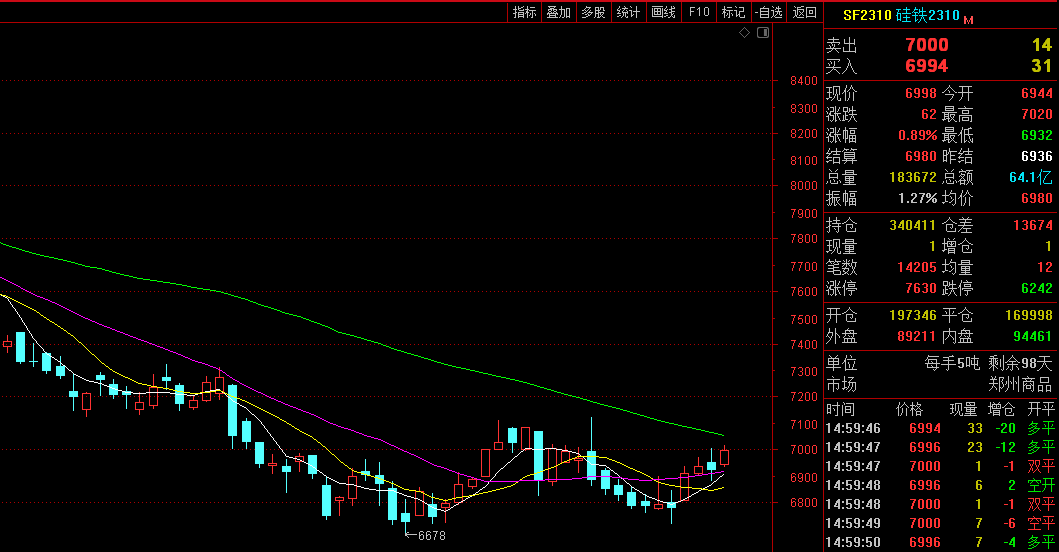On the supply side: In some regions, electricity prices have been lowered, and the price of semi-coke remained relatively stable after increasing. The overall ferrosilicon production cost changes were not significant, and the supply has remained stable with a slight decrease, while the operating rate has remained relatively low; On the demand side: The tender gradually released in July, and the steel mills showed a clear willing to force prices down. The game between supply and demand remained strong, and the actual transaction performance was average; Futures side: The Futures market was volatile and upward, and the weekly opening price of 2310 main contracts was 6,800, the highest price was 7,020, the lowest price was 6,718, the closing price was 6,998, the settlement price was 6,980, the trading volume was 588,568, and the position was 340,411, an increase of 2.13%. Although the ferrous series has rebounded recently, it was difficult for downstream demand to improve significantly in the short term due to the influence of the traditional off-season consumption.
Below are Ferrosilicon Futures main contract daily specific performances:
|
Date |
Opening price |
Highest price |
Lowest price |
Closing price |
Settlement price |
Trading volume |
Positions |
Range |
|
7.10 |
6800 |
6846 |
6718 |
6778 |
6796 |
79862 |
311664 |
-1.08% |
|
7.11 |
6808 |
6940 |
6808 |
6910 |
6882 |
116812 |
316164 |
1.68% |
|
7.12 |
6910 |
6974 |
6900 |
6938 |
6944 |
93827 |
324146 |
0.81% |
|
7.13 |
6950 |
7004 |
6880 |
6920 |
6936 |
114395 |
326737 |
-0.35% |
|
7.14 |
6944 |
7020 |
6932 |
6998 |
6980 |
183672 |
340411 |
0.89% |

Downstream, according to data from CISA, in early July 2023, key steel enterprises produced a total of 22.4037 million tons of crude steel, with a daily output of 2.2404 million tons, a decrease of 0.25% compared to the previous period; Inventory of key steel enterprises was 15.8983 million tons, an increase of 1.1181 million tons or 7.56% compared to the previous ten days (i.e. late June); An increase of 94000 tons or 0.59% compared to the same period last month. In the traditional off-season of consumption, terminal demand was weak, transaction performance was average, crude steel production has slightly decreased, factory inventory has rebounded, social inventory has slightly accumulated, and export growth was also under pressure (China exported 7.508 million tons of steel in June, a decrease of 848000 tons compared to the previous month, a decrease of 10.1% month on month). The steel market was unlikely to improve significantly in the short term, and was expected to continue to operate mainly in narrow fluctuations.

With the increased trading volume, the domestic magnesium market has rebounded slightly this week. In terms of factories, due to insufficient operating rates due to high temperatures, the production side has not yet recovered, and there was not much shipping pressure. There was a strong willingness to increase prices, and the probability of a significant reduction in magnesium prices was low; But after all, in the traditional off-season, the market's demand expectations were not high, and the supply and demand pattern has not fundamentally changed. The magnesium market also lacked the ability to continue to move forward. On Friday, the mainstream ex-factory cash quotation including tax of 99.9% magnesium ingots in Fugu area was mostly around 20900-21000 CNY/T. Pay attention to changes in supply and demand relationships.
- [Editor:kangmingfei]



 Save
Save Print
Print Daily News
Daily News Research
Research Magazine
Magazine Company Database
Company Database Customized Database
Customized Database Conferences
Conferences Advertisement
Advertisement Trade
Trade





 Online inquiry
Online inquiry Contact
Contact

Tell Us What You Think